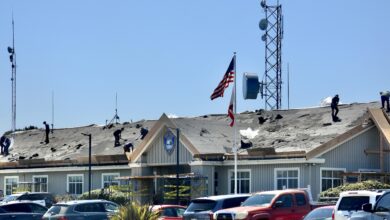Protected areas may help abalone, but confuse people
(This fifth article in the continuing series on the Marine Life Protection Act Initiative will show how our area has protected its abalone in the past from both poachers and big outside interests, and will identify evidence that Marine Life Protected Areas will be good for abalone.)
There is solid scientific evidence that the marine reserves sought by the 1999 Marine Life Protection Act will help reverse a half-century long decline in California”s red abalone populations.
On the other hand, Marine Life Protection Act Initiative organizers do not appear to understand the value of the unique localism that preserved abalone species here, a grassroots protection that now appears at risk from the MLPAI itself.
In Southern California, overfishing destroyed all five commercially-viable abalone species, each of which once supported a fishery there. All abalone fishing is now banned south of San Francisco, with no current hope for revival.
Water temperature changes, water quality issues and the revival of the sea otter off Monterey have also contributed to the slide of abalone populations into oblivion.
At the other end of the state, the local culture has created a radically different picture.
Mendocino Coast fishermen and community leaders from 1949 onward blocked creation of a commercial abalone fishery for red abalone, the only large abalone abundant this far north. According to Ron Karpov, retired Department of Fish and Game biologist, the reason was that recreational abalone divers realized the resource was limited and easily fished into oblivion.
While commercial abalone extraction continued unabated in Southern California, Northern Coastal leaders went a step further in the 1960s.
Local fishermen successfully pushed the DFG to enact a ban on all tank-assisted sport diving for abalone. That created an effective closed area in all waters deeper than 30 feet (about as deep as a person can go holding their breath and wielding an abalone bar.) It also kept out big fishing interests and kept abalone fishing small and local — the way Northern California communities like it.
“This management measure created a de facto refuge for abalone in deeper water, where most divers can”t reach them,” said Jim Martin of the Recreational Fishing Alliance. “This population replenishes the shallow water areas and sustains the fishery.”
North Coast abalone
To investigate how the MLPAI might impact local abalone populations, I interviewed DFG biologist Peter Kalvass, who leads the three-person state team of scientists stationed in South Noyo Harbor.
A local legend is abalone once could be easily picked off the rocks by the dozens at low tide. Kalvass saw that myth become reality when the Stornetta Ranch Preserve just north of Point Arena became property of the state four years ago. The oceanfront area of the ranch was opened to the public and soon that low-tide abalone population was quickly wiped out (by our local, legal fishery), he said.
That property was closed again in the recently completed MLPAI process for the area between San Francisco and Point Arena.
“I had never seen legal-sized abalone at the water line like that,” Kalvass said. “Now it”s a chance to study the recovery there.”
Kalvass thinks some of the worries about MLPAI are overblown and sees potential for study and long-term benefit.
“I have always been kind of surprised we only had the one closed area (Point Cabrillo) in 200-plus miles,” Kalvass said. “We could be the leaders — if we do this right, it will be a blueprint for other temperate climate areas. There are already a lot of reserves in tropical areas.”
In September, DFG will release a multi-year, in-depth study that should be the cornerstone of science to be used by the MLPAI.
The DFG”s 2005 abalone recovery and management plan (available online at www.dfg.ca.gov/marine/abalone.asp) shows much of the abalone science available, along with many gaps in the information. Kalvass hopes the MLPAI process can help bridge those gaps and improve abalone management.
What does the
science show?
Abalone are primitive survivors of earlier epochs of evolution, with more than 100 species found around the world. Abalone shells have stacked cells that are tougher than rocks and deflect when struck. Engineers have used abalone shell technology in recent development of body armor, according to online studies.
More relevant to the MLPAI are the weird sexual practices of abalone.
Abalone reproduce through the least romantic process possible. Fixed to a rock, the male and female release egg and sperm separately, with no knowledge of the other”s efforts.
“It”s the most primitive process of sexual reproduction there is,” said Kalvass.
To increase the possibility of sperm-egg collisions in the water, females can release up to 12 million eggs, with larger ones producing vastly more, studies at Van Damme State Park have shown.
Those studies said Marine Life Protected Areas will help protect larger female abalone, which are so prized by divers.
Will marine reserves actually concentrate abalone and thus improve reproduction rates? That answer may be “no.”
At the coast”s only existing marine reserve at Point Cabrillo, red abalone numbers in deep water have plunged, possibly as a result of sea urchin competition, the DFG abalone recovery plan states. Urchin and abalone compete for space and urchin can obliterate the kelp that abalone rely on.
Kalvass points out that marine reserves are designed to save entire ecosystems, not single species beloved by fishermen, like abalone. He said worries about urchin “barrens” are contradicted by the co-existence of a fished abalone area which is also an urchin reserve on the south end of Caspar beach.
Scientists are increasingly learning that putting nature back together is often a humpty-dumpty exercise. Ecosystems have changed and can”t be simply left to bounce back, many studies have shown. Some native species can actually be wiped out by others through such efforts. Ocean pollution, fishing and global warming have transformed the oceans.
Like many locals, Kalvass says sufficient monitoring and increased study must be included in the MLPAI for the idea to be successful .
Studies show abalone do migrate seasonally from shallow to deeper waters, for reasons not entirely clear. They evolved a frustrating hiding in crevasses talent not to foil humans but another free diver, the sea otter, studies show.
Most relevant of all to the MLPAI process of locating closed areas is the continuing mystery of how the ocean can spread newly hatched abalone.
Larvae settle on the bottom and begin developing a shell within two weeks of the collision between sperm and egg. Many end up very close to their parents.
The short time abalone spend as free floaters means a marine protected area would share its bounty with only a small area. More study would be needed to identify the type of marine reserve needed to facilitate this. But that won”t happen in the next 18 months, which is the MLPAI timetable.
A lot of published science shows marine protected areas will benefit abalone, with an even greater benefit to other intertidal species, which are often trampled by abalone divers.
Concerns beyond the science
One local objection to the MLPAI is the corporate culture of uniformity the initiative seems to come with. To some it feels more like the heavy hand of Southern California culture than environmental preservation. In regions to the south, the MLPAI has honed an approach which involves locals finding somewhere to put no fishing and limited fishing puzzle pieces of pre-determined sizes.
The MLPAI is funded by a reclusive and wealthy private foundation and is being marketed by sometimes aggressive public relations people.
The private MLPAI offers no funds to compensate the community for lost economic revenue, nor is there any sign of any local spending of the millions being spent to implement the MLPA. A 2005 state report estimated that visiting abalone divers alone bring $12.5 million annually to the economies of the three coastal counties where the sea snails survive.
Ocean activists like local resident Judith Vidaver of the Ocean Protection Council say preservation will backfire if it puts out of business the local fishers who practice sustainable harvesting.
One fear Vidaver has voiced is that the MLPAI process will eliminate small local users and encourage ocean industrialization in the form of fish farms and wave energy plants. Both of these have serious consequences for the oceans but, strangely, neither is even contemplated by the MLPAI process.
In fact, the MLPAI has been a friend to those in other regions who want to practice aquaculture, despite consistent science that shows that to be only harmful to the ocean and its critters, if beneficial to dinner tables.
MLPAI Executive Director Ken Wiseman said fish farms are not part of the MLPAI agenda.
Wiseman was familiar with the stories of coast residents rebuffing corporate efforts to use the ocean for oil and wave energy extraction.
But he seemed surprised when told how Fort Bragg residents had also rebuffed an abalone farm a decade ago, partly because it also would be a local resource controlled somewhere else. Fish farms are equally unpopular here with fishermen and environmentalists.
In Southern California, limited liability companies and global conglomerates provide the structure for most ocean operations, including new commercial fishing enterprises. Southern California”s small communities have mostly been subsumed in a “bigger is better” culture.
The Mendocino Coast culture is far different, a place where new chain outlets are sometimes picketed and where a local-food movement has arisen separate from conservative and liberal divisions.
With all abalone harvesting eliminated in Southern California, corporate abalone farms have blossomed. There, an abalone parasite, sabellid polychaete, was imported from global farming operations in South Africa. The worm, which slows growth and makes shells brittle, spread to abalone farms all over California, along with many public aquariums and even study facilities, according to numerous scientific studies found online.
At one point, the worm escaped into the wild in Southern California through an abalone farm”s outfall. That escape was “probably” contained by killing wild abalone in the immediate area of the escape, the DFG report states.
Closed vs. open areas
Another worry expressed by Martin and others is that closing some areas will simply cause the same number of sport divers to hit the remaining open areas harder.
Wiseman said that”s why it”s so important for local people to participate in the extensive public process of selecting sites for closure.
Another difficulty the MLPAI presents is identifying closed areas, Kalvass said.
Kalvass thinks big, contiguous areas work better than small patchworks of marine reserves.
“You don”t want to keep burdening the public with new rules and regulations if there are too many of these, it”s just too much,” said Kalvass.
“Even putting up signs to mark a closed area can be an expensive, big deal. And those are not visible from the water. This simply has to be factored in as part of the [ongoing] cost of doing business …. You just have to think about not doing a bunch of smaller reserves.”
Every diver must fill out an abalone report card and mail it to the state at the end of the year. The average reporting diver took nine abalone in 2007.
(Subsequent MLPAI articles will explore how the initiative may impact seaweed and rockfish.)




